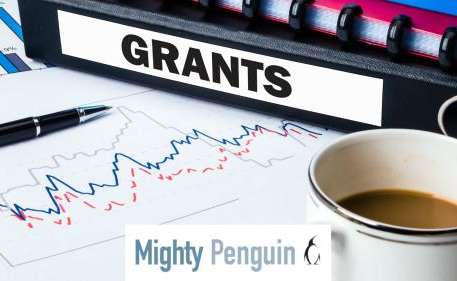Mighty Penguin Speaks
Mighty Penguin Speaks offers fresh insights and best practices in nonprofit management to help you stay informed and up-to-date on the latest trends.
Whether you're an established nonprofit or just starting out, our resources can help you make a real difference in your community.
October 13th 2025
Strategic fundraising starts with naming your North Star. What would the world look like if your work were done? That vision — your North Star — is th
How to NOT Drive Your Donor Base Crazy!
September 15th 2025
Fundraising is part of nonprofit life—it spreads your mission, builds community, and brings in the revenue your programs need to thrive. However, no
Launching a Planned Giving Campaign (Without Losing Your Mind)
August 8th 2025
Planned giving is one of the most powerful—but often underused—tools in a fundraiser’s toolkit. It’s not flashy. It doesn’t promise quick wins. But wh
June 30th 2025
Let’s face it—gift planning can feel like a mystery. But it doesn’t have to be. This post is here to enlighten and inspire you with practical ways to
Building Major Donor Relationships That Inspire Giving
June 2nd 2025
In today’s fundraising environment, meaningful donor engagement is more important than ever. High-capacity donors typically support fewer nonprofits—a
How to Weave Planned Giving Into Major Donor Conversations
May 19th 2025
How to Weave Planned Giving Into Major Donor Conversations In 2025, successful fundraising is all about building genuine relationships, sparking mea
How to be Extremely Effective with your Time in 2025
January 3rd 2025
We’ve made it—2025 is here! What a wonderful year it’s shaping up to be. As professionals, we often have an endless list of tasks but limited time to
Securing Corporate Sponsorships in 2025: The Easier Way
January 2nd 2025
Corporate sponsorships can transform your nonprofit’s fundraising game—but landing them requires strategy, preparation, and a personal touch. Here’s h
How to Find More Grants to Support the Good Work You’re Already Doing
December 6th 2024
Securing grant funding can be a game-changer for nonprofit organizations looking to expand their impact. But where do you start? Crafting a solid gran
How Your Family Can Make a Difference this December
November 18th 2024
December is the Super Bowl of fundraising. Every nonprofit is hustling to secure funds so they can have another successful year of programs. December





![In today’s fundraising environment, meaningful donor engagement is more important than ever. High-capacity donors typically support fewer nonprofits—and those they choose must demonstrate measurable impact, financial responsibility, and visionary leadership. These donors see their contributions as investments in change. This guide offers practical strategies for building strong relationships with major donors, cultivating meaningful conversations, and making confident, effective asks. Understanding Major Donors: Who Are They and What Do They Value? Major donors often: Prioritize fewer organizations where they can make a significant impact Seek out nonprofits with clear missions and strong leadership Expect transparency, accountability, and results Understanding their values: Spend time learning about their values, interests, and giving philosophy Cultivate relationships rooted in trust and shared purpose Treat them as mission partners, not just check writers The Five I’s: A Relationship-Driven Approach to Major Giving Strong donor relationships are built over time. One proven framework is the Five I’s: Identify – Use your data to find high-potential donors Inform – Share stories of impact that resonate with their values Interest – Spark curiosity with tailored outreach Involve – Engage them meaningfully in your mission Invite – Extend a clear, timely ask for their support Common Pitfalls to Avoid Many fundraisers spend too much time behind a desk. While reports and newsletters are useful, transformational giving happens through personal connection. Ask yourself: When was my last in-person meeting with this donor? Am I relying too much on mass communication? Do I make important requests face-to-face? Fundraising is relationship-building. You wouldn’t deepen a friendship through email alone—apply the same thinking here. Who Should You Prioritize? Use your time and energy wisely by zeroing in on those most likely to give generously and consistently. Start with: Top Lifetime Supporters – Your most loyal donors are often your best prospects for transformational gifts. Recent High-Level Donors – Look at the top 50 donors from the past few years—they’ve already shown strong interest. Active Foundation and Corporate Funders – These partners may be open to increased support or multiyear commitments. Long-Term Engaged Supporters – Volunteers, board members, or advocates with deep mission alignment can become major donors. Wealth-Screened Prospects – Use wealth indicators and capacity ratings to surface new high-potential individuals. Pro Tip: Don’t just pull a list—dig into the story behind the giving. Look for patterns, passions, and relationships that can guide your outreach strategy. Key Habits for Successful Donor Engagement Strong donor relationships are built through consistency and intentional effort. These habits can help you stay focused, build trust, and move relationships forward. Prioritize in-person meetings Face-to-face conversations build connection and trust. Schedule regular donor visits. Set clear goals and track your progress Determine how many donor touches or meetings you want each month. Monitor your results. Create accountability structures Ask a colleague or supervisor to help keep you on track with your outreach. Follow up on milestones Reference birthdays, anniversaries, or professional achievements to reconnect meaningfully. Take time to understand their interests Ask thoughtful questions about their passions and values. Show you’re listening. Vary your communication channels Mix emails with phone calls, handwritten notes, and text messages to keep things fresh. Be persistent, not pushy Keep reaching out until you get a clear yes or no—most gifts take multiple touchpoints. Time your outreach strategically Try calling on Friday afternoons or early weekday mornings when schedules may be more open. Don’t underestimate the power of consistency. Small, genuine efforts add up to long-term, transformational relationships. Be bold and gracious. Donors want to help. You’re giving them a chance to create real change. What Do You Talk About? Begin with Discovery Great fundraising starts with listening. Use open-ended discovery questions to better understand your donor: What first drew you to our organization? Are there particular programs or areas of our work that resonate most with you? Can you share what motivated you to give in the past? What aspects of our current work are you most passionate about? Where do you see the greatest potential for our organization’s growth or impact? When your family thinks about giving, how do you typically decide where to focus? What gives you a sense of fulfillment or joy when you make a charitable gift? Is there anyone in your network who might also be excited about what we’re doing? Remember, it's not always appropriate to ask for money at the first meeting. Let the donor know that this is just a conversation and you’re not asking for a gift today. However, it's okay to ask if it would be okay to come back in a few weeks to discuss support or a larger leadership gift. Bring a concise, well-designed take-home packet that outlines giving options. Make sure it’s powerful, polished, and brief. Track all insights and updates in your donor database—it’s your most powerful tool. Framing the Ask: Align, Inspire, Invite Once you’ve built trust and laid the foundation, schedule another meeting to make the ask. Aim to make the ask within the first 15–20 minutes—you’ve already done the groundwork. Suggested Meeting Flow: Reconnect around your shared commitment Reflect on the relationship and emphasize your mutual dedication to the cause. Cast a compelling vision and outline the opportunity Share the big picture, along with the specific funding need that aligns with the donor’s interests. Extend the invitation to give Make a confident, respectful ask—clearly stating the amount and purpose, then giving space for reflection. Sample Ask Phrases: “Would you be open to making a leadership gift of $25,000 to move this work forward?” “You spoke about how much [program] resonates with you. Would you consider supporting it with a $10,000 contribution?” “This initiative is ambitious, and we’re turning to our most committed partners to help lead the way. Would a $50,000 investment be something you’d consider?” Set a follow-up plan: “Would it be okay if I followed up in two weeks after you’ve had a chance to talk with your spouse or partner?” Following Up with Purpose Follow-up is where many fundraisers lose momentum—but it’s also where relationships deepen. Be proactive, confident, and thoughtful in how you re-engage. Call or email with a polite, confident check-in: “Have you had a chance to consider the leadership gift?” “We’re wrapping up this campaign soon—can I answer any questions?” “Is there any additional information I can provide to help with your decision?” “Have you had a chance to discuss this with your family or advisor?” “Does this opportunity still align with your giving goals this year?” Keep the relationship warm and engaged Finding Organic Ways to Connect Again: Follow-up doesn’t always need to be about the ask. Offer value and build connection through updates and shared interests: Share a success story tied to the program they care about Send a photo or short video that shows their impact Forward a media article that features your work or a relevant issue Let them know about a new partnership or milestone you’ve reached Congratulate them on a personal or professional accomplishment (based on social media, news, or conversation) Invite them to join you at an upcoming community event or behind-the-scenes tour Offer a quick “thinking of you” note or check-in to keep the connection alive Practical Tips for Major Donor Success Consistent, personalized touchpoints build trust and show that you see the donor as a partner. Nurture those already engaged Thank generously, often, and personally Show them their impact Create a system for staying in touch Offer meaningful engagement beyond the ask Tailor your communication to their preferences Celebrate milestones together Donors want to feel seen, valued, and essential to your success. Personalized communication builds trust and loyalty over time. Don’t Forget: Planned Giving Can Be a Powerful Strategy In 2025, successful fundraising is all about building genuine relationships, sparking meaningful dialogue, and offering donors opportunities to create long-term impact. One powerful yet underutilized strategy is integrating planned giving into major donor conversations. Planned giving refers to charitable contributions that are arranged in advance and typically allocated from assets such as wills, trusts, life insurance policies, retirement funds, or appreciated stock. Read a previous article about how to Weave Planned Giving into Major Donor Conversations to learn more about this powerful strategy. Need Support? Partner with Mighty Penguin Looking for expert support in developing your major donor strategy, refining your messaging, or building a sustainable fundraising program? Mighty Penguin specializes in helping nonprofits build brave messaging, design high-performing development systems, and create authentic donor engagement strategies that lead to transformational gifts. From customized coaching to campaign consulting, we’re here to help you succeed. Final Word: You’ve Got This Major gift fundraising isn’t about pressure—it’s about partnership. When you lead with curiosity, respect, and boldness, donors feel inspired to join you. You’re offering them a chance to make a real difference. That’s a powerful invitation—and one worth accepting. In today’s fundraising environment, meaningful donor engagement is more important than ever. High-capacity donors typically support fewer nonprofits—and those they choose must demonstrate measurable impact, financial responsibility, and visionary leadership. These donors see their contributions as investments in change. This guide offers practical strategies for building strong relationships with major donors, cultivating meaningful conversations, and making confident, effective asks. Understanding Major Donors: Who Are They and What Do They Value? Major donors often: Prioritize fewer organizations where they can make a significant impact Seek out nonprofits with clear missions and strong leadership Expect transparency, accountability, and results Understanding their values: Spend time learning about their values, interests, and giving philosophy Cultivate relationships rooted in trust and shared purpose Treat them as mission partners, not just check writers The Five I’s: A Relationship-Driven Approach to Major Giving Strong donor relationships are built over time. One proven framework is the Five I’s: Identify – Use your data to find high-potential donors Inform – Share stories of impact that resonate with their values Interest – Spark curiosity with tailored outreach Involve – Engage them meaningfully in your mission Invite – Extend a clear, timely ask for their support Common Pitfalls to Avoid Many fundraisers spend too much time behind a desk. While reports and newsletters are useful, transformational giving happens through personal connection. Ask yourself: When was my last in-person meeting with this donor? Am I relying too much on mass communication? Do I make important requests face-to-face? Fundraising is relationship-building. You wouldn’t deepen a friendship through email alone—apply the same thinking here. Who Should You Prioritize? Use your time and energy wisely by zeroing in on those most likely to give generously and consistently. Start with: Top Lifetime Supporters – Your most loyal donors are often your best prospects for transformational gifts. Recent High-Level Donors – Look at the top 50 donors from the past few years—they’ve already shown strong interest. Active Foundation and Corporate Funders – These partners may be open to increased support or multiyear commitments. Long-Term Engaged Supporters – Volunteers, board members, or advocates with deep mission alignment can become major donors. Wealth-Screened Prospects – Use wealth indicators and capacity ratings to surface new high-potential individuals. Pro Tip: Don’t just pull a list—dig into the story behind the giving. Look for patterns, passions, and relationships that can guide your outreach strategy. Key Habits for Successful Donor Engagement Strong donor relationships are built through consistency and intentional effort. These habits can help you stay focused, build trust, and move relationships forward. Prioritize in-person meetings Face-to-face conversations build connection and trust. Schedule regular donor visits. Set clear goals and track your progress Determine how many donor touches or meetings you want each month. Monitor your results. Create accountability structures Ask a colleague or supervisor to help keep you on track with your outreach. Follow up on milestones Reference birthdays, anniversaries, or professional achievements to reconnect meaningfully. Take time to understand their interests Ask thoughtful questions about their passions and values. Show you’re listening. Vary your communication channels Mix emails with phone calls, handwritten notes, and text messages to keep things fresh. Be persistent, not pushy Keep reaching out until you get a clear yes or no—most gifts take multiple touchpoints. Time your outreach strategically Try calling on Friday afternoons or early weekday mornings when schedules may be more open. Don’t underestimate the power of consistency. Small, genuine efforts add up to long-term, transformational relationships. Be bold and gracious. Donors want to help. You’re giving them a chance to create real change. What Do You Talk About? Begin with Discovery Great fundraising starts with listening. Use open-ended discovery questions to better understand your donor: What first drew you to our organization? Are there particular programs or areas of our work that resonate most with you? Can you share what motivated you to give in the past? What aspects of our current work are you most passionate about? Where do you see the greatest potential for our organization’s growth or impact? When your family thinks about giving, how do you typically decide where to focus? What gives you a sense of fulfillment or joy when you make a charitable gift? Is there anyone in your network who might also be excited about what we’re doing? Remember, it's not always appropriate to ask for money at the first meeting. Let the donor know that this is just a conversation and you’re not asking for a gift today. However, it's okay to ask if it would be okay to come back in a few weeks to discuss support or a larger leadership gift. Bring a concise, well-designed take-home packet that outlines giving options. Make sure it’s powerful, polished, and brief. Track all insights and updates in your donor database—it’s your most powerful tool. Framing the Ask: Align, Inspire, Invite Once you’ve built trust and laid the foundation, schedule another meeting to make the ask. Aim to make the ask within the first 15–20 minutes—you’ve already done the groundwork. Suggested Meeting Flow: Reconnect around your shared commitment Reflect on the relationship and emphasize your mutual dedication to the cause. Cast a compelling vision and outline the opportunity Share the big picture, along with the specific funding need that aligns with the donor’s interests. Extend the invitation to give Make a confident, respectful ask—clearly stating the amount and purpose, then giving space for reflection. Sample Ask Phrases: “Would you be open to making a leadership gift of $25,000 to move this work forward?” “You spoke about how much [program] resonates with you. Would you consider supporting it with a $10,000 contribution?” “This initiative is ambitious, and we’re turning to our most committed partners to help lead the way. Would a $50,000 investment be something you’d consider?” Set a follow-up plan: “Would it be okay if I followed up in two weeks after you’ve had a chance to talk with your spouse or partner?” Following Up with Purpose Follow-up is where many fundraisers lose momentum—but it’s also where relationships deepen. Be proactive, confident, and thoughtful in how you re-engage. Call or email with a polite, confident check-in: “Have you had a chance to consider the leadership gift?” “We’re wrapping up this campaign soon—can I answer any questions?” “Is there any additional information I can provide to help with your decision?” “Have you had a chance to discuss this with your family or advisor?” “Does this opportunity still align with your giving goals this year?” Keep the relationship warm and engaged Finding Organic Ways to Connect Again: Follow-up doesn’t always need to be about the ask. Offer value and build connection through updates and shared interests: Share a success story tied to the program they care about Send a photo or short video that shows their impact Forward a media article that features your work or a relevant issue Let them know about a new partnership or milestone you’ve reached Congratulate them on a personal or professional accomplishment (based on social media, news, or conversation) Invite them to join you at an upcoming community event or behind-the-scenes tour Offer a quick “thinking of you” note or check-in to keep the connection alive Practical Tips for Major Donor Success Consistent, personalized touchpoints build trust and show that you see the donor as a partner. Nurture those already engaged Thank generously, often, and personally Show them their impact Create a system for staying in touch Offer meaningful engagement beyond the ask Tailor your communication to their preferences Celebrate milestones together Donors want to feel seen, valued, and essential to your success. Personalized communication builds trust and loyalty over time. Don’t Forget: Planned Giving Can Be a Powerful Strategy In 2025, successful fundraising is all about building genuine relationships, sparking meaningful dialogue, and offering donors opportunities to create long-term impact. One powerful yet underutilized strategy is integrating planned giving into major donor conversations. Planned giving refers to charitable contributions that are arranged in advance and typically allocated from assets such as wills, trusts, life insurance policies, retirement funds, or appreciated stock. Read a previous article about how to Weave Planned Giving into Major Donor Conversations to learn more about this powerful strategy. Need Support? Partner with Mighty Penguin Looking for expert support in developing your major donor strategy, refining your messaging, or building a sustainable fundraising program? Mighty Penguin specializes in helping nonprofits build brave messaging, design high-performing development systems, and create authentic donor engagement strategies that lead to transformational gifts. From customized coaching to campaign consulting, we’re here to help you succeed. Final Word: You’ve Got This Major gift fundraising isn’t about pressure—it’s about partnership. When you lead with curiosity, respect, and boldness, donors feel inspired to join you. You’re offering them a chance to make a real difference. That’s a powerful invitation—and one worth accepting.](/images/econa-article-images/118/intro/500/resized/event-planing-tips-and-tricks-2_457x281.jpeg)




